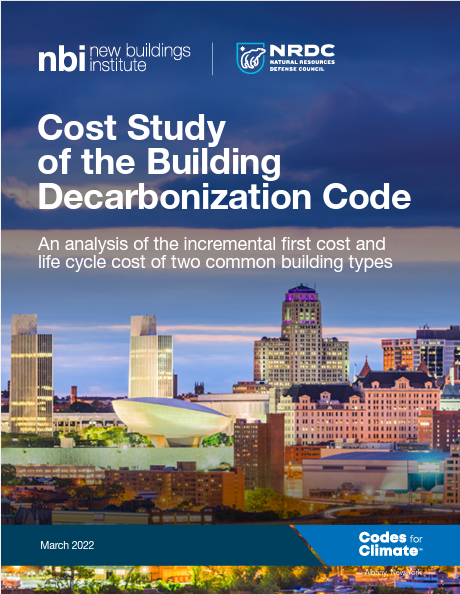Cities, states and other governmental entities have immense power to cut carbon emissions for everyone. Between the nearly 10 billion square feet of commercial real estate that governments own and their responsibility to determine how all buildings are constructed, the potential savings they can create is enormous. But, these savings are only achievable if governments adopt and widely champion zero energy/zero carbon building techniques.
 New Buildings Institute envisions a future where every government building is zero energy with significant carbon reduction benefits. The transformation of jurisdictions’ built environment to zero energy could save more than 88 million metric tons of carbon dioxide (the equivalent of taking 20 million cars off the road for a year.)
New Buildings Institute envisions a future where every government building is zero energy with significant carbon reduction benefits. The transformation of jurisdictions’ built environment to zero energy could save more than 88 million metric tons of carbon dioxide (the equivalent of taking 20 million cars off the road for a year.)
We are currently working with a number of state and local government entities at various levels and stages including:
- Developing building and energy codes that move government agencies and their citizens toward a zero energy / zero carbon future. To develop the best tools for each agency, NBI consults its Multi-Measure Matrix (M3 Tool), a dynamic inventory of measures that appear in energy codes and standards as well as those that are under development.
- Creating code “roadmaps” that engage the community in improving energy efficiency codes and chart a policy-based path to meet energy and climate goals
- Analyzing public buildings through our Public Building Portfolio Management approach to assess and prioritize portfolios for energy use and recommend retrofits with the highest potential for energy savings or zero energy achievement
- Training government stakeholders, building owners, architects, trade allies and others to overcome barriers that prevent rapid adoption of zero energy / zero carbon building techniques
- Custom webinars, charrettes, guides, and training tools, covering best practices for creating and operating ultra-low energy and zero energy buildings
NBI has helped forward-thinking cities, states, and other governmental entities with consultative and educational support. Our team has assisted:
- Cities: Los Angeles, Washington D.C., San Jose, Seattle, Chicago, Atlanta, Portland, Santa Monica, Cambridge (MA), Boulder (CO), Denver, Reno (NV), Providence (RI), Vancouver (BC), San Francisco, Phoenix, New York City, San Mateo (CA), Grand Rapids (MI), Missoula (MT), Tacoma (WA)
- States: California, New York, Massachusetts, Washington, Vermont
- School Districts across the country
Resources

Public Buildings Portfolio Management
To meet decarbonization goals, an effective strategy to track, manage, and improve municipal building performance is a critical component of city leadership in the buildings sector. With support from the U.S. Department of Energy and the Northwest Energy Efficiency Alliance, and a team of subject matter experts, we have developed the Public Buildings Portfolio Management framework to enable cities to lead by example by focusing on the city’s own building portfolio.

Building Decarbonization Code
To meet decarbonization goals, an effective strategy to track, manage, and improve municipal building performance is a critical component of city leadership in the buildings sector. With support from the U.S. Department of Energy and the Northwest Energy Efficiency Alliance, and a team of subject matter experts, we have developed the Public Buildings Portfolio Management framework to enable cities to lead by example by focusing on the city’s own building portfolio.
Read the Building Decarbonization Code

Cost Study of the Building Decarbonization Code
This report analyzes the incremental first cost and life cycle cost of two common building types that follow the code language in NBI’s Building Decarbonization Code. The study, supported by the Natural Resources Defense Council (NRDC), analyzes first costs for both all-electric and mixed-fuel paths for single-family and medium office prototypes. It also includes life cycle cost analysis for the single-family scenario. Researchers used cost data from New York State, a relatively expensive market, in colder Climate Zone 5A.

Moving Energy Codes Forward: A Guide for Cities and States
Moving Energy Codes Forward: A Guide for Cities and States provides critical steps to achieve significant code improvements through the adoption of stretch codes and provides a practical framework for implementing advanced codes and outcome policies. It offers guidance, resources and examples of advanced code adoption based on New Buildings Institute’s stretch code development and adoption experience working with states and communities.

Energy Code Roadmaps for Getting to Zero Outcomes
Advanced energy codes are an important policy mechanism to advance energy efficiency and integrate renewables into the built environment. Energy code roadmaps lay the groundwork by identifying the order and priorities necessary for subsequent code improvements on the path to zero energy and zero carbon emissions. This Energy Code Roadmaps for Getting to Zero Outcomes publication document highlights code and policies mechanisms that can be leveraged by cities and states interested in pursuing outcome-based building policies.

Zero Energy Commercial Building Targets
The critical first step in achieving a zero energy building is to set an energy use target. This Zero Energy Commercial Building Targets white paper helps define appropriate goals for these ultra-low energy buildings, which often surpass even the most stringent energy codes in place today. Targets that address whole-building energy use are also effective tools to overcome barriers in the existing energy code framework to move the market toward zero.
Additional Resources:
The Technical Basis of Building Performance Standards
As leading cities and states seek to meet their aggressive climate, energy, and decarbonization goals, they are turning increasingly to mandatory policies that require improved energy and emissions performance across their existing building stock. The paper will consider how standards for existing buildings, including ASHRAE Standard 100 and ASHRAE Standard 105, are being referenced in setting these parameters. The methodology and level of these metrics in a BPS directly impacts which actions will be taken by building owners to meet its technical requirements.
